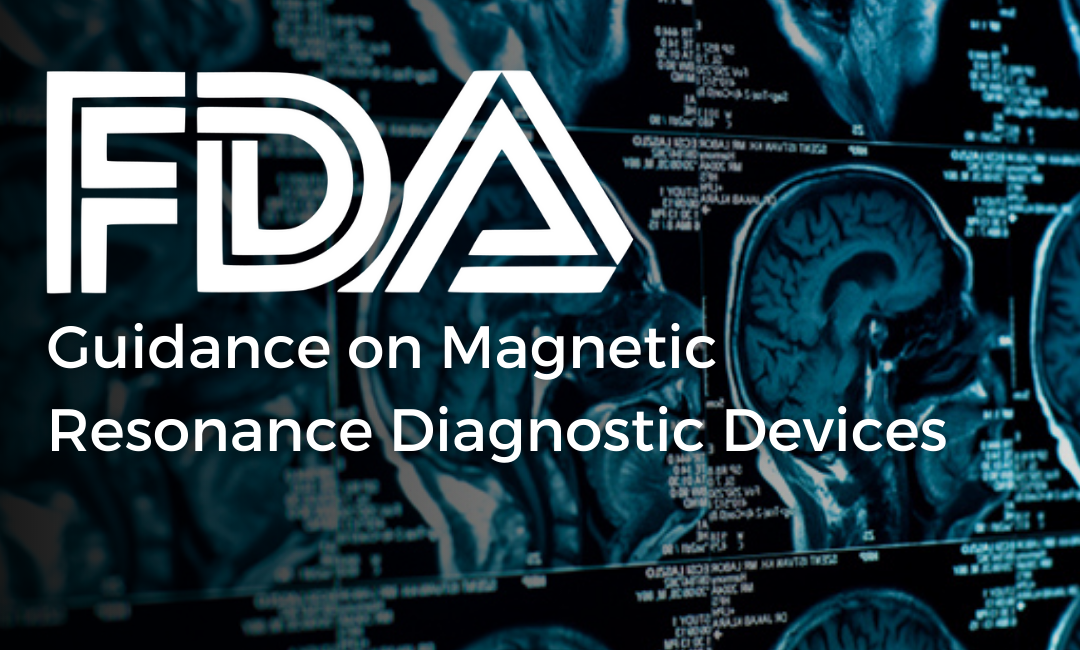The Food and Drug Administration (FDA or the Agency), the US regulating authority in the sphere of healthcare products, has published guidance dedicated to the submission of premarket notifications for magnetic resonance diagnostic devices. The latest version of the document was issued in December 2016.

The FDA guidance does not introduce new rules and requirements itself but provides additional clarifications regarding the applicable regulations, as well as recommendations to be considered by the parties involved when taking measures necessary to achieve and sustain compliance with the respective regulatory requirements. The authority explicitly states that an alternative approach could be applied, provided such an approach complies with the regulations and has been approved by the FDA in advance.
Table of Contents
Regulatory Background
The present FDA guidance outlines the scope of information to be provided by the applicant in the context of a premarket notification for a magnetic resonance diagnostic device (MRDD) in accordance with the provisions of 21 CFR 807.87 as the main regulation on the matter and in accordance with the general requirements for 510(k) premarket notifications. The authority also states that additional information on certain procedure aspects could be found in separate guidance documents dedicated to different 510(k) pathways and the refuse to accept policy for 510(k)s . The regulatory approach described herein is aimed to simplify and streamline the regulatory procedures associated with placing MRDDs on the US market.
The FDA mentions that the magnetic resonance diagnostic devices should comply with the radiological health requirements set forth by the appropriate section of the Code of Federal Regulations, as well as with the applicable requirements prescribed by the Federal Food, Drug, and Cosmetic (FD&C) Act. The present FDA guidance is based on current versions of the aforementioned regulations and thus could be subject to amendments deemed reasonably necessary to reflect new changes to the underlying legislation.
According to 21 CFR 892.1000, MRDD covered by the scope of the present guidance are devices intended for general diagnostic use to present images which reflect the spatial distribution and/or magnetic resonance spectra which reflect frequency and distribution of nuclei exhibiting nuclear magnetic resonance. The devices of this type are Class II medical devices under the applicable risk-based classification. Consequently, they are subject to premarket notification and determination of substantial equivalence in order to be allowed for marketing and use in the US. The scope of the FDA guidance covers medical devices with the codes LNH, LNI, and MOS.

The MRDDs usually consist of:
- The main magnet,
- Shim and gradient systems,
- Radiofrequency transmitter and receiver,
- Transmit and receive coils,
- Power supplies,
- Computer and Software,
- Patient supports, and
- Physiological gating devices.
The scope of the present FDA guidance covers premarket notifications for magnetic resonance imaging (MRI) and magnetic resonance spectroscopy (MRS) systems, as well as any components or accessories thereto.
As mentioned, an applicant will have to demonstrate substantial equivalence before placing a new product on the market. In this regard, the FDA refers to the applicable voluntary consensus standards medical device manufacturers may use for this purpose. Additionally, the standards introduced by the National Electrical Manufacturers Association (NEMA) could be used. However, these standards describe only the standard measurement methods to be used, not the particular acceptance criteria one can apply. Hence, the manufacturer will have to determine the acceptance criteria itself.
Another standard to be used for MRDDs is the International Electrotechnical Commission (IEC) 60601-2-33 “Medical Electrical equipment – Part 2-33: Particular requirements for the basic safety and essential performance of magnetic resonance equipment for medical diagnosis.
Apart from those mentioned above, the present FDA guidance indicates other applicable standards, such as:
- ISO 10993-1 – Biological evaluation of medical devices (in terms of patient contenting materials),
- NEMA PS 3.1 – 3.20 DICOM,
- AAMI/ANSI ES60601-1 – Medical electrical equipment, and
- IEC 60601-1-2 – Medical electrical equipment.
Magnetic Resonance Diagnostic Device Description
In order to assist medical device manufacturers in completing and submitting the applications, the guidance also provides clarifications and recommendations regarding the way the magnetic resonance diagnostic device should be described in a 510(k) premarket notification. As stated in the document, the applicant shall indicate the applicable regulation and product code and provide the information described in the guidance, namely:
1. Indications for Use. First, the applicant shall provide the Indications for Use (IFU). All other supporting documentation accompanying the device should be aligned with these Indications. At the same time, the authority mentions that specific clinical indications fall outside the scope of the present guidance. The FDA encourages the applicants to contact the regulating authority in advance to clarify the aspects related to the matter.
2. Device Description. Another important element of the submission is a detailed description of a medical device in question, including all its components and parameters. This section should also include a description of the software used. In this regard, cybersecurity issues should be considered.

Physical Laboratory Testing
As mentioned, the applicant will have to demonstrate substantial equivalence for the magnetic resonance diagnostic device in question. For this purpose, the appropriate performance testing results are to be provided. The testing should be performed in a way prescribed by the applicable standards. The authority also states that the particular testing to be performed should depend on the features and characteristics of a medical device subject to review.
According to the document, in order to demonstrate the performance of a medical device, the applicant shall provide the details on the assessment of image quality metrics. The guidance further provides the particular metrics to be used, such as:
1. Imaging: Signal to Noise Ration (SNR), Geometric Distortion, Image Uniformity, Slice Thickness, Spatial Resolution, Image contrast validation.
2. Spectroscopy: Spatial Localization Accuracy, Spectral Resolution, Signal to Noise Ratio, Water suppression, Decoupling, Spectral Data Processing.
In terms of the safety of a medical device, special metrics should be used as well. In particular, the medical device manufacturer shall evaluate such metrics as Acoustic Noise, Gradient-induced Nerve Stimulation, RF Energy Deposition, Surface Heating of RF Receive Coils, Biocompatibility and Fixed parameter options.
Additionally, the applicant shall provide samples of clinical images in order to demonstrate the device in question could be used to generate diagnostic quality images. Such images should be submitted in electronic DICOM format, provided that all patient identifiers have been removed.
In summary, the present FDA guidance describes how the interested party shall prepare and submit a 510(k) premarket notification related to a magnetic resonance diagnostic device. In particular, the document describes the scope of information to be provided to the authority with regard to the medical device in question, as well as the format to be used.
Sources:
How Can RegDesk Help?
RegDesk is a next-generation web-based software for medical device and IVD companies. Our cutting-edge platform uses machine learning to provide regulatory intelligence, application preparation, submission, and approvals management globally. Our clients also have access to our network of over 4000 compliance experts worldwide to obtain verification on critical questions. Applications that normally take 6 months to prepare can now be prepared within 6 days using RegDesk Dash(TM). Global expansion has never been this simple.

